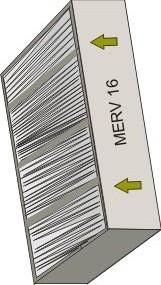Filtration = High-Capture Filtration Technology

With most furnace and air conditioner systems, indoor air is continually recirculated, distributing and redistributing dust, pollen, mold spores, pet dander and other indoor air contaminants. Filters installed at the furnace or return air registers can trap some of these contaminants, thus helping to clean the indoor air. Air filter efficiency is defined in MERVs. MERV stands for “Minimum Efficiency Reporting Value.” A typical 1-inch-thick spunfiberglass furnace filter has a rating of 1 to 4 on the MERV scale and can trap particles like sawdust, carpet fibers, dust mites, and pollen. ENERGY STAR Certified Homes requires filters to be at least MERV 6; these filters can clean the air of most cement dust, mold spores, animal dander, and hair spray. DOE's Zero Energy Ready Home program requires that filters be at least MERV 8; these filters can capture nearly all of the 3- 10-micron particles. Even higher MERV levels are available. HEPA filters with MERV ratings from 17 to 20 can filter out particles smaller than 0.3 microns, including viruses. Higher MERV filters restrict airflow so builders and HVAC contractors wishing to install them must carefully size the ducts and filter box to allow for thicker or wider filters, which will allow for more air flow.